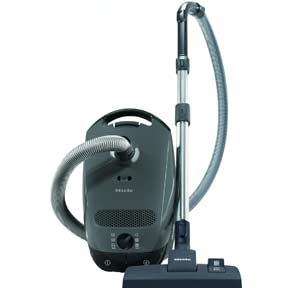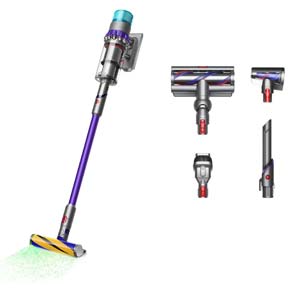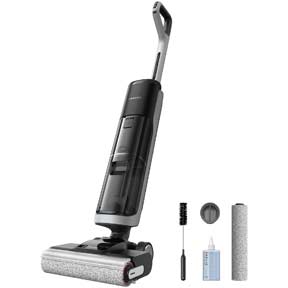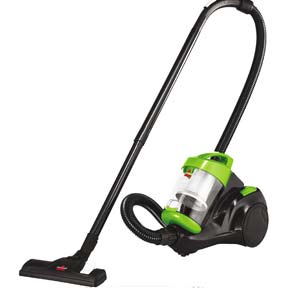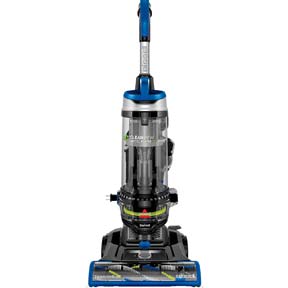Dyson Vacuum Cleaner Review
Review Of Dyson Vacuum Cleaners
In 1978, a man named James Dyson was vacuuming when he realized that the vacuum bag was slowing down the air flow and suction capability of his vacuum. Instead of looking for a more powerful vacuum (like most of us would), Dyson decided to invent one where the bag would not cause suction loss.
He went through over 5000 prototypes before he came up with the Dyson vacuum cleaner line, the “first vacuums that don’t lose suction.” Dyson offers three lines of upright vacuum cleaners: the DC07, the DC14, and the DC15. All are upright, and all are bagless.
The Debate: Bag vs. Bagless
You wouldn’t believe what strong opinions people have about vacuum bags! It’s quite controversial.
Bagless vacuums are the newest trend. They save you money because you don’t have to buy replacement bags. Manufacturers tout them as being cleaner than vacuum bags and easier to empty. Most allergy specialists do agree that full vacuum bags can expel a good deal of dirt and particles through the exhaust of most vacuums.
Bagless vacuums, however, are likely to expel just as much through most their exhausts. Specialists also argue that emptying bagless vacuums simply puts all of the dust and particles back into the air. They’ve recommended using vacuums with bags and changing the bag out when it is only two-thirds full.
How Dyson Vacuums Work
Dyson vacuum cleaners answer these concerns with their patented “RootCyclone” technology. They create a “cyclone” or centrifuge in the middle of the vacuum that spins to separate air from the dirt, dust, and other particles.
The dirt stays in the vacuum, and the exhaust from Dyson vacuum cleaners is supposed to be cleaner than the air you usually breathe. According to independent tests, the emissions are incredibly low with Dyson vacuums.
The next test of bagless vacuums is emptying the container. Most of the time, you have to disconnect the container part. This exposes dirt trapped in the container to the air. Next, you have to dump the container upside down into the trash, which usually ends up in all the dust in the container spewing back into your face.
At one point in during the process of inventing 5000 prototypes, James Dyson also thought of an answer to this problem. On all Dyson vacuums, the container is completely sealed, even after you disconnect it to the unit. You simply press a release button. You carry it to the trash by the handle and put it over the trash. The container remains right-side-up.
You then press another release button, and the bottom of the container opens to easily dispose of the contents. Depending on how full your trash is, some of the particles could still blow up, but the same could happen with a two-thirds full vacuum bag.
This is a great system for bagless vacuums. If anyone in your home has severe allergies, you should empty the container outside to be safe.
Which Dyson Vacuum Cleaner is the Best?
There are a variety of models available within the three lines of Dyson vacuum cleaners. The DC07 is the least expensive (around $350-$450 depending on model). It is also the hardest to use. Its controls are reported as confusing, the attachments are difficult to use, and it’s not very easy to maneuver.
If you’re going to buy a vacuum to last, you should pay the extra $100 or so and go for one of the DC14 or DC15 models.
The DC14 and DC15 lines offer the basic vacuum, and each model then adds a particular group of features for a specific cleaning function. Animal hair, all floors, bare floors, complete, and full gear are some of the models. The DC14 and DC15 are very similarly priced. The DC15 is also known as “The Ball,” and it offers very smooth maneuverability. The DC15 also has easier controls and the attachments are easier to use. Other than that, your choice depends on the specific uses. Both lines have a special animal hair model.
One of the DC14 models comes with a dusting tool, and one comes with a flexible crevice tool. The DC15 line is better for carpets as they come with motorized brush bars.
Dyson vacuums lack suction control, but they have air escapes that make it possible to clean draperies and rugs. They also don’t have manual pile adjust. The DC15 models have an automatic adjust and are good at low pile carpet and high pile carpet. If you have something in between, the beater brush might not reach your carpet, leaving you with not-as-clean carpet.
Dyson more than makes up for these slight problems by offering exceptional features on all of its vacuum models including lifetime HEPA filters. The filters are washable, so you don’t have to replace them. Dyson vacuums also don’t use belts, so you save even more money not having to repair and replace those as well. They are also great on stairs with long attachment hoses. Even the independent agencies usually against bagless vacuums recommend Dyson vacuum cleaners.

